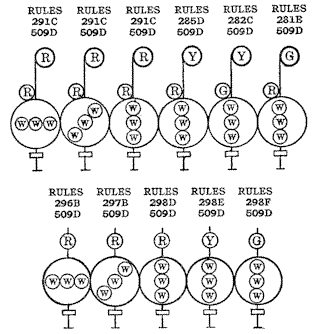Auto. Sig. 781-1 | Spencerville |
" " 795-1 | Ohio City |
" " 805-1 | Wren |
" " 835-1 | Markle |
" " 841-1 | Huntington |
" " 851-1 | WO. Siding |
" " 870-1 | Disko |
" " 884-1 | Rochester |
" " 900-1 | Monterey |
" " 915-1 | North Judson |
" " 937-1 | Boone Grove |
" " 948-1 | Crown Point |
" " 956-1 | Griffith |
Rule 509-d, paragraph (b) is amplified as follows: | |
When telephone train order signals are set at 45 degrees above horizontal or yellow light, indicating that the train should take siding and siding cannot be used, making it necessary to back the train over to the opposite track, this signal may be passed without first bringing the train to a stop and may proceed at restricted speed until the rear end of train clears the crossover. After permission has been received from the train dispatcher or signalman in charge, the train may back over to the opposite track, protecting the movement as prescribed by Rule 99. | |
| |
POSITION LIGHT TELEPHONE TRAIN ORDER SIGNAL. | |
A position light unit attached to pole below upper unit. | |
 | |
When position light telephone train order signals are in service, rules 509-B, 509-C and 509-D will be observed the same as where other types of signals are in use. | |
ROUTE SIGNALS. |
Route Signals are the middle unit on 3-unit home signals at HN. Tower westward, SJ. Tower DA. Tower and Kingsland both eastward and westward; Bolivar eastward; Newton westward; RS. Tower and Delong both eastward and westward; Wilders eastward; Kouts westward; Griffith eastward for C. & O. trains only. |
Normal position of route arm is horizontal, red light by night. Forty-five degrees above horizontal, yellow light by night indicates that the route from one main track to the other has been set up. |
Route Signals at the above locations (except Griffith) will be used only to permit trains operating with current of traffic to cross over to the opposing main track. |
The provisions of Rule 221, Rules of the Operating Department, effective July 1, 1930, are amplified as follows to apply only at the above named locations: (except Griffith). After train orders have been transmitted, and made complete and train order signal displayed, operators will then set up the route for crossover movement and line the route signal without first waiting for approaching train to acknowledge the combination of signals. |
All the other provisions of Rule 221 remain in effect. |
When acting on route signal indication at above named locations (except Griffith) no train or engine will proceed on opposing track without having received necessary train orders and clearance card Form A. |
|
INSTRUCTIONS GOVERNING CROSSOVER AND OTHER MOVEMENTS AT OHIO CITY. |
When either eastward or westward trains are to be operated against the current of traffic from Ohio City, following procedure will govern: |
Interlocking signals will be displayed at stop and train order indicating light will be displayed. |
EASTWARD--Approaching trains will acknowledge this combination of signals and after receiving restricted speed signal may proceed into interlocking limits where operator will deliver necessary train order and permission to use crossover. Conductor will see that switches are properly lined after being used. |
When restricted speed signal is displayed at eastward home signal, and train order indicating light is not displayed, trains will proceed looking out for instructions to enter siding. |
WESTWARD--Trains will come to a stop to clear east switch of crossover and trainman will call on phone located on outside of east end of tool house for instructions and permission to use crossover. After permission is given, train will then cross over and proceed into interlocking limits on proper signal indication where necessary train orders will be delivered. Conductors will see that switches are properly lined after being used. |
(8)